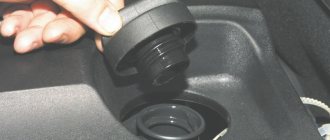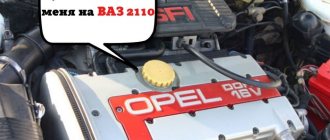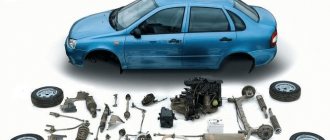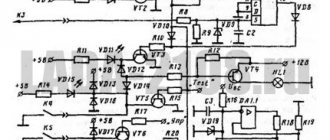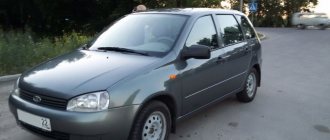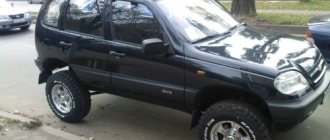How to insulate a Lada Granta radiator
Yes, the man was confused, BUT HOW did he design it. and thermal imaging images and timeline graphics!
Of course, it’s too much to insulate a car like that, but he has the time and desire!
The car blanket is a VERY GOOD idea! Thanks for the links comrades!
| Volgar056 |
| View profile |
| Find more posts by Volgar056 |
Well, the first measurement results.
The car is parked from 7-50 to 12-00 on the street (conditions are above. By 10-00 about -35C). Under the same conditions (close in temperature, humidity and lack of wind + warming up at the same level in the morning), I will conduct two more tests. In general, I’ll remove all the insulation and pull everything out of the muzzle, except for the standard one (it’s reinforced with 4mm isolon under clips). And the third test is to put felt in place, the face and a bunch of two large rags while parking, I stuff them into the steering rod windows (the effect of closing the steering rod windows is interesting).
| www-shurik |
| View profile |
| Send a private message to www-shurik |
| Find more posts by www-shurik |
before launch
start.jpg According to the RP5 website, it was -24C. And the air pressure sensor is connected to the supply hose after the thermostat
(about 20cm from him and wrapped in isolon). Those. not to be confused with outside temperature
(street one post higher)
. Judging by his testimony, it siphons a little - it's stock.
warm up 6 minutes
The first 6 minutes without the heater on, then at 2nd speed.
average per trip
Consumption is average, but with such a trip it’s impressive)))
I took the photo immediately after the trip timer jumped from 13 minutes to 14 minutes (I waited about 1 minute at XX, still near the garage)
This is subject to availability
these are the fur coats
The tie rod windows are open. The radiator is closed at the top and bottom. The next test is that I remove all the insulation and similarly warm up for 6 minutes and then near the house I wait for the end of the 14-minute trip to XX.
from lunch after warming up from 220V - the same in the morning
average with warm engine
| www-shurik |
| View profile |
| Send a private message to www-shurik |
| Find more posts by www-shurik |
| www-shurik |
| View profile |
| Send a private message to www-shurik |
| Find more posts by www-shurik |
It's -30C now. Today I was late for work (at 8:27 the engine stopped). I closed the steering windows completely (today I’m doing a test of a fully insulated engine, otherwise if I remove the insulation, I decided it would be better before the weekend so that I have time to put it back, if the effect is “WOW”, then I’ll drive with the insulation until March). If in 4 hours it only makes a 5-7 degree difference, then there’s no need for such insulation (or alter it specifically, sew the sides onto felt so that it looks like a cap/hat hanging over the wings).
And I completely forgot to make a “short stop”. Of course I'll try it after lunch, but it will be a little warmer outside. It’s not relevant to me (but someone might be interested in whether it’s worth it or not).
The car stood for exactly 3 hours and according to two sensors under the hood on the supply hose -3C and TOZH -1C (retained about 30 degrees relative to the street).
| www-shurik |
| View profile |
| Send a private message to www-shurik |
| Find more posts by www-shurik |
In 4 hours of parking it turned out to be -9C, T on the hose -10C. Closing the windows had no effect on the results. I took a photo on my mobile phone (but didn’t upload it - the numbers are accurate, then I’ll collect all the measurements from the photo in a pile in the bulletin board).
Operation at XX 6 minutes (without heater) TOZH +52C, T hose = 0. Yesterday it was +50C and +13C (maybe the thermostat works better/worse every other time?)
Upon arrival +64 and +40. Yesterday it was +65C and +41C - a fairly similar result.
I removed the tie rod plugs from lunch (colleagues made fun of their bright yellow color), but left everything else (felt, radiator insulation). If these plugs have any effect, it will only be for the first 20-30 minutes. Then from lunch (at -25C): parking for 1 hour 24 minutes and maintenance: +25C under the hood +20C parking for 2 hours 5 minutes and maintenance: +14C under the hood +10C That is. all the heat and the cooling rate - it was necessary to record the LOG in 30-40 minutes, I’ll leave it in the garage in the evening with the ignition on - let it draw a graph, I’ll just turn off the coil.
Engine cooling system Grants
Design features of the LADA Granta engine cooling system
The LADA Granta engine cooling system is liquid (with forced circulation of liquid), sealed, with an expansion tank. The system is filled with ethylene glycol-based coolant (antifreeze), which does not freeze at ambient temperatures down to -40 'C.
The design of the cooling system of all engines installed on Lada Granta cars is fundamentally the same and is described using the example of a car with a VAZ-21116 engine.
Location of elements of the LADA Granta cooling system:
water pump provides forced circulation of fluid in the cooling system of the Lada Granta, is installed on the front plane of the cylinder block and is driven by a timing belt. The pump has sealed bearings that do not require replenishment of lubricant. The pump cannot be repaired; if it fails (liquid leakage or bearing damage), it is replaced as an assembly.
A thermostat with a solid heat-sensitive filler maintains normal operating coolant temperature and reduces engine warm-up time. The Lada Granta thermostat has a main and additional bypass valve. At a coolant temperature of up to (85±2) °C, the thermostat is completely closed and the liquid circulates through a small circuit, bypassing the radiator, which speeds up engine warming up. At temperatures above 85 C, the thermostat begins to open, and at 102 ° C it opens completely, allowing fluid to circulate through the radiator. An electric fan with a plastic impeller ensures that the radiator is purged with air at low vehicle speeds, mainly in urban conditions or on mountain roads, when the oncoming air flow is not enough to cool the radiator. To increase operating efficiency, the fan is installed in casing 7 and attached to it at three points through rubber pads. The casing, in turn, is attached to radiator 3 at four points. The electric fan is controlled by the engine control unit, which receives information about the coolant temperature from sensor 5 (see Fig. 1), located in thermostat socket 4.
The radiator is tubular-plate, aluminum, with plastic tanks, two-way, with a partition in the left tank. At the bottom right there is a drain plug 6. The tanks contain inlet and outlet hose pipes to the engine water jacket, as well as a hose pipe connecting the radiator to the expansion tank.
The expansion tank serves to compensate for the changing volume of coolant depending on its temperature. The tank is made of translucent plastic. The “MAX” and “MIN” marks are applied to its walls to control the coolant level; on top there is a filler neck, hermetically sealed with a plastic plug 1 with two valves inside (inlet and outlet), assembled in a single block. The exhaust valve opens at a pressure of 110 kPa (1.1 kgf/cm2), ensuring an increase in the boiling point of the coolant and preventing intense vaporization. When a liquid cools, its volume decreases and a vacuum is created in the system. The inlet valve in the plug opens at a vacuum of about 3 kPa (0.03 kgf/cm*) and allows air into the expansion tank.
Note
| The serviceability of the valves of the expansion tank plug is very important for the normal operation of the cooling system, but often when problems arise (coolant boiling, etc.), car enthusiasts pay attention only to the operation of the thermostat, forgetting to check the valves. Leaking of the exhaust valve leads to a decrease in the boiling point of the coolant, and its jamming in the closed state leads to an emergency increase in pressure in the system, which can cause damage to the radiator and hoses. |
The interior heater radiator is also included in the cooling system using hoses.
LADA Granta engine cooling system diagram
Cooling system : 1 — coolant drain hose from the heater radiator; 2 — hose for supplying coolant to the heater radiator; 3 — hose for draining fluid from the engine; 4 — expansion bank hose; 5 - expansion tank; 6 — steam exhaust hose of the engine radiator; 7 — thermostat; 8 — hose for supplying fluid to the engine radiator; 9 — electric radiator fan; 10 — engine radiator; 11 — radiator drain plug; 12 — coolant pump; 13 — supply pipe of the coolant pump.
Replacing tires
Another important point. Despite the fact that there is no snow underfoot or ice yet, it is already possible to perform a seasonal tire change. Better a week earlier than an hour later. No need to worry about premature wear of the studs.
Drive smoothly and avoid high speeds on the highway. Nothing will happen to your spikes.
But after the first snowfall, you won’t have to drive on summer tires, taking risks and balancing on a slippery road like a tightrope walker. You won’t have to rush around looking for a free tire shop.
When choosing a tire workshop, pay attention to the condition of the equipment and what the technicians do.
It is advisable that you tighten the wheel fasteners not with a pneumatic gun or a long wrench, but with a certified torque wrench. Otherwise, you can easily damage and pull the thread. Then, while driving, after the unfortunate masters, the wheel may fly off.
In general, the time has already come. At air temperatures below +5 it is officially recommended to use winter tires.
Remember: the grip of tires on cold asphalt is not the same as in summer conditions.
Be careful, don't rush on the autumn road.
Why does the stove in the Lada Grant not heat well in winter?
Controversial issue
There is only one controversial question that all car owners face: is it possible to soundproof a car with inexpensive building materials (photo above), or is it only necessary to use car noise. So:
- Today there are two opposing opinions regarding building sound insulation in a car.
- The first is voiced by manufacturers of materials for car sound insulation and workers involved in noise insulation - the use of construction sound insulation in cars is not permissible, there will be no effect
- Secondly, from the car owners themselves - the price of a specialized Shumka is unreasonably high, it is much cheaper to use building materials with similar properties
- To answer this puzzling question, you must first understand what exactly is included in the concept of “sound insulation”
Electric heaters
If you live in an area where there are severely frosty days, you will notice that many cars have engine pre-heaters. This makes it easier to start because the engine gets warm before starting. It actually works like an electric water boiler. Heat goes to the fluid, and it flows through the shirts and gives off heat to everything under the hood. True, for such a device to work, you need an outlet nearby. The efficiency is the greatest of all methods.
Sound insulation of the hood
When soundproofing the hood lid, you should take into account its weight, since if you make this part too heavy, the shock absorbers will most likely soon leak. Therefore, it is better to use a light vibration for this area, for example, Vibroplast Silver. It is also worth considering that soundproofing the hood itself is not done in order to get rid of the noise made by the engine. In fact, this is necessary for its insulation. As insulation, you can choose Accent 10, which will retain heat and will not change its properties from high temperatures.
Important! There is no need to throw away the factory thermal insulation, since the new one cannot be a full replacement.
Some cars do not have a factory hood shroud, in which case use the thickest material possible.
Our experiment
The editorial Largus is equipped with a Multitronics C-590 trip computer, which, among other things, allows you to monitor the temperature of the engine coolant with an accuracy of one degree. The information content of a standard device cannot be compared - it shows two tiles on the display if the engine is not fully warmed up, and four at temperatures up to 100°C.
So, during the week, when the temperature in the capital hovered around zero, I collected information about the engine temperature. What happened?
The on-board computer, receiving signals from the “brains” of the engine through the OBD-2 diagnostic connector, displays them on the screen.
The on-board computer, receiving signals from the “brains” of the engine through the OBD-2 diagnostic connector, displays them on the screen.
Warming the Lada Granta engine before winter
As usual, all motorists are fussing and worried before the start of winter. Some prepare in advance, others don’t have time and worry. But it’s better not to waste your nerves, but simply find out the answers to your questions about comfortable driving on the roads and the safety of your car. And one of the most basic questions is how to make sure that the heart of the car does not freeze, that is, insulate the engine, and also maintain a warm atmosphere under the hood. This will be the topic of the article. We will describe the key points and technologies that make it possible to keep the engine warm at all times and any driver will be able to face the winter fully armed.
Car blankets
Many people say that the engine in a car is a completely living organism and it is difficult for it to withstand frosts and sudden temperature changes. Problems and inconveniences may arise. It's as easy as shelling pears to keep the driver warm - just wrap yourself in a blanket. The industry also produces blankets for cars and their parts. These things are called car blankets. They have undeniable advantages - safety, fire resistance and fire safety of the material. All types of blankets are practical and easy to use. Cars that their owners carefully cover give off heat much more slowly, while maintaining the ability to start quickly. Also, this is a great fuel economy for the car. True, a car blanket is not a cheap pleasure, and it is also not very pleasant that its effect lasts no more than five to six hours.
Felt and foil polypropylene
However, fortunately, there is another technology for retaining heat under the hood - it is similar to how a car blanket works. But the effect is directed exclusively to the radiator. You can also use felt in addition to sheets, which provide excellent insulation. Felt can catch fire if it absorbs unnecessary substances such as gasoline or oil. All you have to do is smoke next to such a car - and that’s it, you will be provided with a warm radiator torch. It is best to use foiled polypropylene. It is cheap, easy to process and also flexible, provides reliable permanent thermal insulation and is non-flammable.
Electric heaters
If you live in an area where there are severely frosty days, you will notice that many cars have engine pre-heaters. This makes it easier to start because the engine gets warm before starting. It actually works like an electric water boiler. Heat goes to the fluid, and it flows through the shirts and gives off heat to everything under the hood. True, for such a device to work, you need an outlet nearby. The efficiency is the greatest of all methods.
Thermal protection: how to cover a car's radiator for the winter and photos of completed projects
As already mentioned, a certain part of car owners do not bother at all and place ordinary cardboard cut to a certain size in front of the radiator honeycombs. The method is simple and requires virtually no investment - just securely fasten the tuning part. But, such a picture is possible due to a banal ignorance of other options, so it makes sense to consider them in more detail.
Factory kits
Car owners who know the answer to the question of whether it is possible to close the car’s cooling radiator in winter are advised to look at auto parts stores. Here you can find ready-made kits for preparing a car for cold weather, consisting of engine insulation and radiator honeycombs. The undoubted advantage of this option is expressed in the following points:
- There is no need to look for material for products.
- There is no need to make a pattern or adjust the insulation.
- Kits are produced for a specific model.
The cost of the kits starts from 3,000 rubles. It includes insulation for the engine and radiator. In cases where the engine does not need to be insulated, you can only purchase a radiator damper. Their cost is in the range of 500-700 rubles, although the price for some branded samples (for example, Tammers) reaches 3,500 rubles. Plastic shields are available on the lower part of the bumper. Most inexpensive kits have low thermal insulation characteristics, so some motorists try to make effective analogues on their own. And, I must admit, they are doing this with some success.
Handicrafts
It has already been mentioned that the most basic way to protect a radiator from cold wind currents is to place a simple cardboard. But real aesthetes, of course, will be outraged by such a proposal. Some will start looking for factory products, and those who have their hands in the right place will make an exclusive version for themselves. Experienced car enthusiasts share their experience and how to close the radiator of their car for the winter in the photo, which shows implementation methods. Everyone determines the complexity of execution for themselves:
- The simplest solution is implemented using foil-clad polypropylene, which is cut to the shape of the radiator grille and secured with cable clamps. It is undesirable to use felt material, as it absorbs fuels and lubricants and is prone to ignition.
- A more complex method involves the additional production of a cover made of dermantine or artificial leather. The difficulty of implementation is compensated by the high decorative component, which can become the highlight of the car’s decor.
Radiator grilles with horizontal fins are well closed using pipe insulation. Most often, just two two-meter tubes with a diameter of 34 and 52 mm are enough. Such a kit will cost only 150-200 rubles.
The insulation must be cut into pieces of a certain length and transverse slots made in the places where the reinforcing bars of the grid are located. The structure is inserted into the spacer between the ribs and, if necessary, secured with clamps. The use of this type of thermal insulation is justified at temperatures below -15°C, since such tubes have an impressive thickness, which can lead to overheating of the coolant.
Useful tips
I propose to start acting from the inside from the comfortable driver's seat. If you are bothered by foggy windows too often, you need to check the condition of the air intake box and the degree of contamination of the cabin filter.
Perhaps the accumulation of old leaves and banal filter contamination do not allow you to properly ventilate the interior. To make it easier for you and the engine under the hood to breathe, it is best to replace dirty filter elements without waiting for the next maintenance.
On older car models that did not initially have a cabin air filter installed, it is useful to blow out the heater radiator core from the inside. At the same time, if the heater motor begins to make strange noises when turned on, lubricate its bushings with a few drops of engine oil.
For better visibility, take the time to wipe off the greasy deposits that gradually accumulate on the inside of the glass. Try to keep the flooring dry.
Remember: rubber mats that are damp on the inside cannot be placed in the interior after washing them.
This is another reason why windows quickly fog up. It is advisable to replace windshield wiper blades that have become stiff and dry from the summer heat.
What is sound insulation
Sound insulation usually refers to the reduction of noise in the car interior emanating from the engine, transmission and the environment. Sometimes the noise of tires and the sound of stones in the fender liners are added here:
- In fact, all of the above is only a small part of all the extraneous sounds that occur in the car.
- First, let's remember what any machine is made of - sheets of metal
- And any sheet of metal when the car moves begins to oscillate (vibrate), and vibrations generate noise (hum)
- The answer suggests itself - in order to reliably and efficiently soundproof your favorite car, you need to “chain” (fix) the metal parts so as not to give them a reason to vibrate
- As a rule, this can be done by gluing various materials onto the metal; the instructions will tell you the best ones.
Possible varieties
More recently, soundproofing kits such as Dynamat have become extremely popular:
- The advertisement claimed that the materials were from the category of space (nano) technologies, which “miraculously convert outgoing vibration into heat, and the heat gradually dissipates in the air”
- Of course, this is true (regarding the absorption and dissipation of vibration), but such a transformation can be performed by almost any similar material that is glued to metal, there is nothing cosmic or “Nano” here.
- The cost of the kit with installation was, of course, high.
- But after the crisis we know, a lot has changed, and today the most popular is the production of sound insulation for domestic cars
- Its cost is much lower, it is offered with or without installation, so to speak, for self-installation
- The kit consists of pieces of self-adhesive material, which are cut for all models of domestic cars
- Owners of non-standard, by Soviet standards, cars, in particular foreign cars, are offered “impersonal” kits, represented by sheets of material with an area for processing the car, the size of our Volga.
- Almost any car falls into this category
- If you purchase this kit “with installation,” then everything is clear, but how to treat your car yourself?
- The work is not difficult in principle, but it requires a lot of time and patience.
- It is necessary to completely disassemble the interior of the car, remove all the mats and seats, as well as the upholstery from the roof and doors
- Then the entire space in the cabin should be thoroughly vacuumed and washed, if necessary, remove the factory sound insulation and clean the surfaces down to metal
- Otherwise, your self-adhesive material will not stick to a dusty or anti-corrosive surface.
- After this, the metal needs to be degreased and only then can you stick on your soundproofing sheets
- Difficulties may arise with gluing the ceiling and doors
- The roof generally requires special attention, otherwise all the noise will simply come off and there will be little use from it
- The doors are difficult due to the narrow space; you have to squeeze through the frame reinforcement, go around the door lock rods and window lifter
- The car's noise insulation rating will be higher if special materials are used
Gordon0007 › Blog › Making proper winter insulation on Lada Granta
The Lada Granta, like any other modern AvtoVAZ model, can rightfully be considered a warm car. There are many tales and legends about warm “stoves” in the interiors of “our” cars. Some people call it “Sahara”, while others enthusiastically call it “bathhouse”. All this takes place, the heater of the Lada Grant is indeed worthy of praise for its high performance, but nevertheless, at street temperatures below -40, for the sake of preserving the units and simplifying the operation of the engine, you need to insulate your car. Today we will do this.
How to insulate the Lada Granta?
Many car owners, in the old-fashioned way, in severe frosts, insulate their cars with cardboard inserted between the bumper and the radiator grille, some throw pieces of rags on the radiator, and the most advanced ones clamp a sheet of thick Izolon with the hood lid. All these actions lead to the same result - in the car at -40 and below it becomes really warmer, the engine cools down more slowly and warms up faster. But with all this, the appearance of the car suffers greatly. But thanks to the imagination of the Lada Granta owners, an inexpensive, effective and, most importantly, attractive method of insulating a car was found.
Materials for car sound insulation
Shumka consists of several components, each of which must be made of a specific material.
Vibration isolation
Extraneous sounds appear due to vibrations, the frequency of which is 20 Hz or more. To avoid such a hum, it is necessary to purchase vibration-isolating material, which is made on a rubber basis. It resembles liquid rubber and can be coated with a metallized coating on top. Vibration insulation dampens noise well, and it can be laid either in whole sheets or in strips at equal intervals. This material is sold in sheets measuring 0.5x0.7 m or 0.5x1.2 m. In stores you can find the following brands: Vibroplast, Bimast, Vibroplast, Isoplast, as well as less popular materials: STP SPLEN sound insulation and TEAC. Let's look at some of them:
- Self-adhesive sound insulation Vibroplast Silver with a metallized coating. It is flexible and is an easy-to-use material. Equipped with markings (5x5 cm squares), thanks to which you can easily cut sheets of the required size. Suitable for treating interior floors, doors, roofs, hoods and trunks. Does not require heating. Costs from 100 to 300 rubles.
- Bimast Bomb coated with aluminum foil. To work with the material, it must be heated to 40 - 50 degrees, which is not very convenient, but Bimast has the highest efficiency compared to analogues. Suitable for wheel arches, speakers, tunnel, driveshaft and area above muffler. Costs from 480 rubles.
Healthy! Most vibrations come from the engine compartment, floor and wheel arches. If you have car audio installed, then the doors near the speakers, the rear parcel shelf or the trunk lid may also make noise. The least amount of vibration can be heard from the pillars and roof of the car, so cheaper material can be used in these places.
The vibration material is applied first, followed by the sound insulation itself.
Noise insulation
A sound absorber is made of soft, porous materials designed to absorb sound waves coming from outside. Most often, drivers purchase material for car soundproofing from the following companies:
- Bitoplast 5. This material performs two functions at once - noise absorption and sealing, so you don’t have to buy additional anti-creak. Effectively eliminates rattles and squeaks in the car interior. This material is made from polyurethane foam with a protective anti-adhesive layer. In addition, Biplast retains its properties even at very low temperatures (down to -50 degrees). Costs about 360 rubles.
- Accent 10, which performs only a sound-absorbing function. This material consists of polyurethane foam coated with a metallized film. Allows you to get rid of 90% of noise. Accent 10 is adapted to low temperatures (up to -40 degrees), and it does not deform when heated to +100 degrees. Most often used to process the hood, trunk and engine compartment partition. It also costs about 350-390 rubles.
Important! Do not confuse noise and sound absorbers with soundproofing materials, since they are fundamentally different from each other in their properties and composition.
If possible, it is better to combine Shumka of different compositions. For example, one material can be glued to the outer panel of a car door, and another to the inner panel. When gluing the engine compartment or wheel arches, different materials can be laid directly on top of each other. The fact is that different noise insulations retain different frequency ranges, so thanks to this trick you will achieve a better result.
Another secret. Conventional building materials can be used as a sound absorber. For example, Teksaound soundproofing. It costs an order of magnitude cheaper and is used both for houses or apartments, and for cars. Another such all-rounder is Guerlain (soundproofing).
Attention! The video contains elements of profanity.
There is also liquid Shumka. It is most often used for outdoor work. Materials such as liquid sound insulation of wheel arches have excellent anti-corrosion properties. The composition of this material can be of an aerosol or painting type (for application with a brush or spatula). Mastic liquid sound insulation is resistant to reagents and other aggressive environments.
Padding material
Another material that you should think about buying before you make a car soundproofing yourself is a cushioning (anti-creaking) material. It is used to get rid of unnecessary noise produced when metal parts of the machine come into contact. Previously, its analogue was plasticine, foam rubber, etc., in general, everything that can be found at home. Today there are specialized anti-creaks, for example, “Madeline”. This decorative fabric-based material, about 1-1.5 mm thick, is equipped with an adhesive layer and a protective lining with anti-adhesive properties. Most often, madeleine is used to seal gaps between decorative parts of the interior, car body, air ducts or in the dashboard. Costs about 750 rubles.
If you purchased a universal sound-absorbing material, then there is no need to spend money on a seal. Experts still recommend purchasing all components separately. The fact is that if you buy a universal coating, it will take less work, but the car will gain a lot of weight.
Battery
The battery also requires additional maintenance. This will help prepare the car's electrical system as much as possible for the onset of cold weather.
The most important steps will be cleaning the terminals, charging the battery, replacing spark plugs, treating high-voltage wires and connections with special protective lubricants. It would not be superfluous to insulate the hood using special materials and technologies.
Checking high voltage wires
With the onset of cold, damp weather, I noticed that the engine began to start worse. Therefore, I decided to check and ring the high voltage wires that go to the spark plugs. I removed the tips one by one and rang them with a multimeter. The resistance should be up to 20 kOhm. On my Lada Granta all the wires turned out to be normal.
Now I’ll think about what was the reason for the poor launch. Probably in the spark plugs. By the way, there is another simple way to check high-voltage wires. I turn off the lights in the garage, start the engine and look at the wires. If sparks sparkle across them, then it’s time to change. If there is nothing, then they will come. In order not to bother, you can replace all the spark plugs and a set of explosive wires at once. Fortunately, they are inexpensive on Ladas.
At what temperature should cardboard be removed?
The upper limit of ambient temperature permissible for using cardboard in front of a radiator can be considered +5°C. Monitor the weather forecast, the sea temperature indicator and the frequency of operation of the electric cooling fan.
- To warm up or not to warm up a modern engine? All the details and video are here.
Is cardboard in front of the radiator necessary today? - experiment on Lada
Proper parking of your car will help keep you warm
It sounds funny, but proper parking of the car will help warm up the car interior faster. You should not leave your car in the open overnight. When parking this way, the car will freeze more strongly and take longer to warm up.
You should park in the yard, or even better, in a fenced parking lot. In such places there is no wind; in the morning the car will warm up much faster.
This rule especially applies to residents of towns and villages where open areas predominate.
Soundproofing doors
When processing doors, it is also worth considering the weight of the materials; if they are too heavy, you risk breaking the hinges. Therefore, it is important to understand why you need sound insulation in these areas. If you want to improve the sound, then you can’t do without a little expense and will have to glue at least 4 layers of Shumka. For more “modest” requests, only a vibration applied to the inside of the door opposite the speakers will be sufficient. It is also worth noting that the thinner the metal, the more material you will need.
Before work, the doors must be disassembled, the trim removed and the surface treated with a solvent. In the heat of work, do not forget to leave free space for cables, rods and other wires located in the doors.
First of all, it is necessary to treat the inside of the doors with vibration insulation; for this you can use Vibroplast Silver. In places behind the speakers, Bimast Bomb is suitable. The second layer is Shumka with a thickness of about 4-8 mm. After this, external sound insulation is carried out. The material is glued under the door cards, after which they are covered with anti-squeak.
Attention! The video contains elements of profanity.
Granta 38 4 new size
Holding the wheel in a vertical plane, we alternately sharply pull the upper part of the wheel toward ourselves, and the lower part away from us, and vice versa.
We make sure there is no play (knock). If there is a knock on the front wheel, ask an assistant to press the brake pedal. If the knocking noise disappears, it means the wheel bearing is faulty, and if the knocking noise remains, then the ball joint is most likely worn out.
The hub bearings of the front and rear wheels are not adjustable and must be replaced if there is play.
To check the serviceability of the ball joint, insert a mounting blade between the suspension arm and the ball joint housing. Be careful not to damage the ball joint boot.
Let's start with the engine
First, I insulated the car engine. I put a car blanket on top that I had previously used on other cars. I bought a blanket from a well-known brand of original production, although I think that you shouldn’t trust the advertising. It can be insulated with the same success in other ways. I described this in detail using the example of the Kalina-2 car, which is essentially the same Grant. You can read it here.
The engine warms up faster and cools down longer. This is especially useful for cold regions.
Preparing for soundproofing
First of all, it is necessary to prepare the following tools (in addition to vibration and noise insulation and seal):
- a construction hair dryer (an ordinary household hair dryer will not work in this situation);
- stitching roller (with it you will glue the material to the surfaces of the car faster and better);
- scissors;
- stationery knife (for piercing bubbles);
- solvent or degreaser (they will need to treat the surface; regular White Spirit will do).
After this, dismantle all parts, clear the area and clean the surface of dirt and dust. The room temperature during operation should not be lower than +18+20 degrees. If all conditions are met, you can begin laying the Shumka.
Radiator grille
I put insulation on it, which many people talk about. It was purchased at a hardware store. This is a regular insulation for pipes measuring 22 by 6 mm.
It is quite enough, it fits well. When there is a thaw outside, you can pull out one tube. Cold air does not pass through.
If you are driving on the highway, the car feels very good.
Salon
On the seats I use the winter version of the covers - made of faux fur. With them, the heated seats do not need to be turned on. The steering wheel has a soft braid of eco-leather that does not harden in the cold.
I have fabric on top of the rugs. When you open the doors, snow can get on the floor mats. The stove will melt it, and the water will be absorbed by the fabric. If you just lay a rubber mat, a puddle of water will form on it. You can place a pack of newspapers under the rubber mat. Then the car will always be dry, and your feet will not get wet.
Share your experience on how to insulate the Lada Granta for the winter. But I do it as described and I like it. I don’t impose it on anyone, everyone decides for themselves.
Noise insulation of wheel arches and trunk
The niche for the spare wheel should be completely covered with vibration, the same applies to the plastic lining of the trunk.
Do-it-yourself noise insulation of wheel arches will save you from road noise, especially in winter when studs are used. To process the wheel arches, you must first remove the standard plastic wheel arch liners (but do not throw them away), clean the parts from dirt and dust and treat the free surface with a vibration isolator. The fender liners themselves can also be covered with material.
Attention! The video contains elements of profanity.




